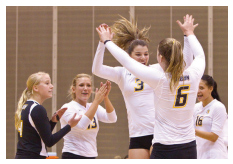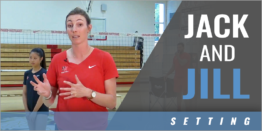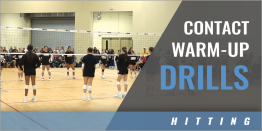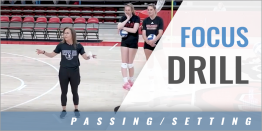|
By: Jay Hosack, Head Coach - George Mason University (Previously at Penn State at the time of this article) Originally Published in: Coaching Volleyball Magazine Provided by: AVCA
In today's game, opposing offenses are bringing more attackers at a faster pace, putting more stress on blockers and defense than ever before. Four or five attackers vs. three blockers does not equate well for the defense. So how does your block counter that type of offense? As the phrase goes, "There are many ways to skin a cat." Here are a few of the most common ways to attack it.
Pre-match Scouting Reports Chances are the coaching staff has charted the tendencies of their opponents. This helps when it comes to determining who you are going to focus on in each rotation. With each rotation in front of you, you should have a clear vision of what your priorities will be, and what your next step will be if those priorities are changed. What do we do vs. a good pass/bad pass situation? Do we read all the time? Do we release certain blockers to front good attackers? There are many thoughts as to how to defend each situation. Some coaches like to read all the time, while others like to scheme their blocks. Releasing blockers to front certain hitters is more common, especially with faster tempo offenses. Remember: When the other team is in system, they have the advantage. A good in-system sideout percentage in volleyball hovers around 68%. That means nearly 7 out of 10 times, they are going to terminate the ball. When they are out of system, things change completely. Blockers should go from a "scheme," to a "read" situation, and rely on their eyes, footwork, and hands to get them to where we need to be. At this point, it's time to be athletic, and just go get the ball. To Swing, or Not to Swing Over the years, I have heard many coaches talk about how their players can't swing block, or that they are not athletic enough to swing block, or they don't have the timing down, and their block has holes in it. That is a lazy answer, to me. If your player knows how to attack a ball, they are already using the fundamental skills necessary to swing block correctly. This skill, when coached correctly, can be achieved with high levels of success at ANY level, with either gender. Secondly, the actual swing blocking move is done in certain situations. It doesn't have to be done every time a blocking move is made. Sometimes, there is a short shuffle move to front their hitter. Other times, blockers are already at the pin, ready to static block.
Trust Your Eyes The phrase we use for our blocking "eye-work" is; Ball-(Hitter)-Setter-Ball-Hitter. Watch the pass to see where it is going, a quick glance at your hitter to see their attack route, look at the setter to see if they are giving away anything early, a quick look at the set to see its speed and location, and finally watch the hitter and be in front of them. Drills Here is a simple drill to help get your blockers to trust their eyes. A coach or player stands in middle back, and passes a ball to the setter, where a set is made to one pin or the other. The blocker(s) on the other side must not cheat and make false steps, but rather get to the spot where the ball is going. They must just make one clean move to where the ball is set. You can progress this drill with different sets, on or off the net passes, and, increasing the speed and reps per blocker (serve receive, then immediate transition reps). Have everyone work from the middle position, to train their eyes and footwork correctly. 1-3 Blockers vs. 1-4 Attackers Isolate your blockers to react to two different sets (i.e. quick and one pin, or quick with a back row attack), allowing them to make specific moves at first. As they increase their skillset, you can add another attacker. This drill should be done fairly regularly, as it warms them up, and gets them in the right frame of mind for the day's drills. Video Session With each day/match, I like to sit down with our blockers to see how they performed. Blocking is a highly-repped skill, with most times little to no payoff for the athlete. The best teams in the country are only averaging three blocks per set. You should discuss with your players the four types of successful blocks: Stuff block, channel block (to your defenders), soft block, or forcing the attacker to change their tendency of attack and either hitting out or in the net or a shot which is picked up. Each one of those is a successful block, and should be rewarded with positive reinforcement. In the end, the goal should be to put as many hands in front of the attacker as possible, therefore forcing them to hit without a clean shot to the court. Try this at your next camp, or practice: Don't allow your players (especially younger kids) to hit in warm ups without a blocker in front of them. This will not only improve your hitter's skills vs. a block, but also allow your blockers to get more reps every day without adding another drill.
We welcome YOUR input! If you have any comments on this article or ideas for another topic, please contact our subcommittee. We are always looking for fresh ideas and ways to better serve the development of our fellow assistant coaches in all levels and types of volleyball. Send your feedback to: EHammond@Towson.edu.
|









